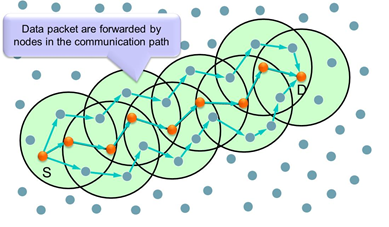Communication links extending between source and destination nodes in a mobile ad-hoc network (MANET) are often broken under a high mobility environment. Although a new communication route can be established when a link break occurs, repeatedly reconstructing new routes incurs long delay and substantial overhead. In particular, such frequent delay is not acceptable for continuous data such as voice communications in a battlefield. The severity of this problem increases exponentially with increases in the number of hops. This weakness has limited today’s MANET to smaller-scale applications (about 50 users) with short connections (i.e., few hops of data relay). To overcome this limitation, we introduce in this presentation a new routing paradigm for MANET, called Mercury-like Routing that uses communication paths instead of the conventional multihop connections.
Communication Path is a new concept for data transmission. To establish a connection, the source node broadcasts a path request message to search for the destination node as in conventional routing. When the destination node receives this message, it sends back a path reply message to the source node using the route of the path request message, but in the reverse direction. In this process, any node in the proximity of this route can hear this message and join the communication path. Thus, a communication path is a dynamically-created geographical area that connects the source and destination nodes. The routing functionality of a communication path is provided by the nodes currently within the geographical region served by this path. They take turns in forwarding data packets for this path (Figure 1). Since a communication path is supported by many alternative nodes, this scheme is much less susceptible to node mobility compared to a conventional connection based on multiple hops of nodes.

Before a communication path becomes broken, the destination node can inexpensively update the path by sending to the source node a path update message using the route of the last received data packet, but in the reverse direction. Any node that can hear this message along the relay participates in the new communication path. By refreshing the communication path periodically, the path appears to dynamically change its shape (like mercury) as it follows the source and destination nodes to maintain their connectivity. Such a MANET approach is much more robust, suitable for large-scale applications that require long connections with many hops of data relay.
